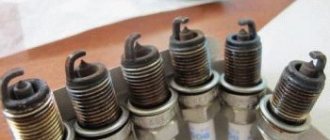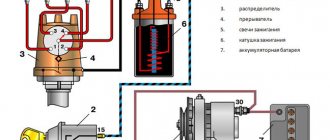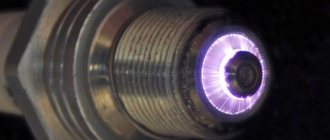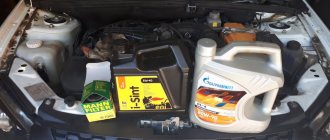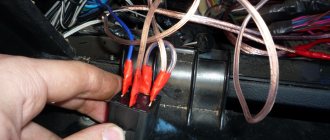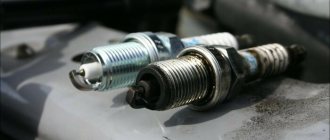Materials from which modern spark plugs are made
Many modern manufacturers of these parts are constantly improving their products, making spark plug electrodes from various materials. Therefore, some may be expensive, while others are designed for the budget class.
But the operating principle of these engine elements remains unchanged; a strong current passes through them, forming a spark that ignites the combustible mixture created in the combustion chamber.
The main elements of candles are electrodes, between which a spark is formed; they are made of metal. Therefore, in some cases, their service life directly depends on the electrode material from which it is made. Therefore, the answer to the question of how often to change spark plugs lies in this plane. That is, this process directly depends on what metal the electrodes are made of.
To figure out how long it takes to change these parts, you need to not only carefully study the instructions, but also listen to the signals that come from the power unit during its operation.
Classification of spark plugs according to the material of their electrodes:
- metal candles, their main elements - electrodes, are made of simple metal that does not have any additional coating, these parts are characterized by a budget cost, so they have to be changed more often;
- iridium, platinum spark plugs, their electrodes are made of metal, the surface of which, under special conditions, is coated with iridium or platinum; they are expensive, but their service life is much longer.
Now let's look at how often you need to change spark plugs made using iridium or platinum.
According to the technical data that manufacturers establish for them, the service life of such spark plugs is 100 thousand kilometers.
Now let’s look at how many kilometers it is necessary to change spark plugs made of simple metal.
Manufacturers set a barrier of 30 thousand km of engine mileage.
But, despite the stated technical indicators, every car enthusiast should understand that this period or mileage can be reduced if the engine runs on poor (poor quality) fuel, or under increased loads. It is also necessary to replace these elements if you buy a used car.
It is important to remember the most important advice. When purchasing spark plugs, the car owner should carefully read the instructions for their use. It will necessarily indicate the mileage that the car must travel before the spark plugs are completely replaced. Even if, after passing this distance, the car enthusiast sees that the spark plugs are in normal condition, in any case they must be completely replaced with new ones.
OPERATIONAL CHECK
To accurately determine whether it is time to change the high-voltage wires of the VAZ, you need to check their performance with a multimeter.
This operation will take you no more than 15 minutes:
- Turn off the ignition;
- We remove the wires: disconnect the first end from the ignition module, the second from the cylinder;
- We switch the tester to ohmmeter mode and connect the multimeter probes to the wire contacts.
If the high-voltage wires on the VAZ 2114 are in normal technical condition, the multimeter will show a resistance within the value indicated on the wire insulation; if the readings are different, the armored wires on the VAZ 2114 need to be replaced. The process must be repeated on each wire in turn.
If the test shows disappointing results, there is a possibility that the problem of increased resistance lies in oxidized contacts. In this case, you can try to revive the VVP by wiping the contacts with VD-40 or carburetor cleaning fluid.
Also, the cause of problems with ignition can be a breakdown of the GDP. You can determine it visually in the dark - take a flashlight and open the hood of the fourteenth, find and inspect the armored wires, if you notice a slight spark on the insulation - the air intakes are broken and need to be replaced.
The question of why so much attention is paid to ignition devices can be answered as follows. They are one of the main elements of the internal combustion engine, ensuring its stable and economical operation. You can ideally adjust the thermal gap in the valves, set the ignition timing according to the instruments, fill in the highest quality gasoline, but all it takes is one poorly functioning spark plug, and everything done will be in vain.
Spark plug
Device:
- Contact nut for high voltage wires;
- Spark plug insulator with fins;
- Medium electrode;
- Ceramic insulating layer;
- Metal part of the insulator;
- Radio interference suppression resistor;
- Metal ring for sealing;
- Washer for heat removal;
- Central electrode;
- Conical thermal insulator;
- Candle workspace;
- Side electrode;
The letters indicate the operational dimensions: d – thread diameter; h – gap for spark gap; L – length of the working part; l - thread length; S – key size.
All structural elements of devices are important in their own way, but the leading role belongs to the central electrodes. Therefore, they require special attention to themselves. Candles must have the following properties:
- Resistant to high temperatures;
- Good thermal conductivity;
- Plastic;
- Resistant to corrosion and erosion.
Therefore, to implement all these requirements, nickel alloys with various additives are used in manufacturing. There are ignition devices in which the electrode is coated with platinum. The main purpose of spark plugs is to ignite the air-fuel mixture at the end of the compression stroke.
When it is necessary to change spark plugs, even if they have not served their intended lifespan
In our country, the majority of motorists use used cars, the power units of which have worked out a significant resource. Poor quality fuel, defective spark plugs, and other factors (for example, low current) can affect the quality of operation of these parts.
If the driver begins to notice malfunctions in the engine, which will be discussed below, then these parts will have to be replaced, and such work will have to be done immediately in order to protect the entire power unit from major damage.
Signs of engine operation in which the spark plugs require replacement.
- The engine doesn't start well. If a car owner begins to notice that his power unit, after a long period of inactivity, either constantly starts up, not immediately, but after some manipulations with the ignition switch, then the car is giving a signal that cleaning or replacing the spark plugs is required. This behavior is caused by the fact that the spark formed between the electrodes has weakened and does not completely ignite the combustible mixture, or does not ignite it at all.
- The engine is tripping. If, while driving or accelerating, a motorist feels the engine is not working properly, this should tell him that the piston system is not working correctly, that is, some pistons do not provide force to the crankshaft. And this means that in some combustion chambers, the mixture does not ignite.
- Presence of black exhaust gases. This circumstance indicates that the amount of incendiary mixture involved in the movement of the piston increases sharply. That is, due to improper operation of the spark plugs, their sparks do not ignite the entire mixture that accumulates in the combustion chamber. If there is a large amount of it, detonation occurs, which leads to the formation of black smoke. But that is not all. Severe detonation destroys the surface of the pistons and cylinders.
- The presence of a significant amount of liquid in the catalyst and exhaust pipe. If you look closely at the exhaust pipe while the engine is running, you will notice that a certain amount of condensate flies out of it. In ideal condition, condensation always forms, but if liquid literally flows from the exhaust pipe, then this is a signal that not all fuel is burned. If this happens, it means that a weak spark does not ignite the combustible mixture at all, or its combustion does not occur in full.
- Loss of power. If, while driving, a car enthusiast begins to feel that his car is not picking up speed well, or is driving jerkily, it means that the power unit is sending a signal about poor performance of the spark plugs.
This is when you need to change spark plugs if, according to the manufacturer’s technical requirements, they have not yet exhausted their service life.
It is important to remember that without the normal operation of the ignition system, the engine will not only lose power. In its depths, a high temperature will arise, which is formed from the combustion of a combustible mixture exceeding the established volume, and this will destroy the piston rings and allow oil to enter the combustion chamber.
Spark plugs must be replaced after they have reached the end of their service life. If a car enthusiast begins to notice improper engine operation and loss of power, then this is also a signal to replace them. Otherwise, the power unit may become unusable, or its repair will be expensive.
Spark plugs are used in a car to create the spark necessary to ignite the fuel-air mixture in the cylinders of the power unit. Poor spark plug performance due to carbon deposits and other reasons can cause uneven engine operation. Today we will look at the question of how often you need to change spark plugs and what determines their correct operation.
Candles must be selected taking into account the recommendations of the company that manufactured your car. The question of how long the spark plugs last is of interest to almost every car enthusiast; there is no definite answer to it. You need to understand that if we are talking about a new car, then its owner must undergo regular maintenance. As a rule, the first maintenance must be completed after 10 thousand kilometers traveled. During the procedure, specialists also change the spark plugs.
When to change spark plugs can also be determined by the absence or presence of carbon deposits. If you see that a lot of carbon has already accumulated on the spark plug, it must be replaced immediately, and the service life of the spark plugs does not matter in this case.
Causes
The most common of them is the incorrect operation of the car's electronic unit. What’s most interesting is that the spark plugs on the injector are filled more often in winter at subzero temperatures than in summer. And this is not an anomaly. There are objective reasons for this. As the temperature drops, mixing the fuel-air mixture becomes more difficult because a large amount of oxygen requires a large volume of gasoline in cold air. In this regard, the electronic control unit sends a signal to the fuel injectors, thereby increasing the amount of fluid supplied. This is the main reason why the candle floods.
What is happening in the engine at this moment? The injectors supply gasoline to the combustion chamber of the engine, while the starter tries to create the necessary compression in the cylinders, while at the same time trying to produce a spark to generate a flash. At the same time, we should not forget about the quality of our fuel - a lot of impurities and dirt significantly worsen the operation of the injectors, hence the corresponding troubles.
With ideal compression, the spark plugs can easily start even with a minimal impulse, but this only happens on new cars. Therefore, it fills spark plugs on the injector most often on cars more than 3-5 years old.
When to change spark plugs - determining factors
The frequency of replacement of spark plugs is determined taking into account various points. Below, only the main ones will be considered. First of all, it is worth noting that the service life of original products is several times longer than the service life of “non-original” ones. Many branded spark plugs work even 50 thousand kilometers without problems, but for third-party products this is unrealistic.
The service life of spark plugs largely depends on the quality of the fuel.
Those who constantly fill their car with low-quality gasoline change the spark plugs quite often. Since low-quality fuel is very common in our country, many drivers regularly wonder how long to change spark plugs. As a rule, this procedure must be performed every 20,000 - 30,000 kilometers traveled.
Experienced car owners can easily determine when to change spark plugs. The sound and operation of the engine changes, an incomprehensible noise occurs, as well as vibration, in some cases the car even begins to twitch.
In addition, the condition of the spark plugs depends on how well it is carried out, as well as the product itself. Low-quality oil often leads to the rapid appearance of carbon deposits on spark plugs, which negatively affects their service life. An excessively high or low oil level in the engine can lead to similar results.
Under what conditions will the spark plugs not be filled with gasoline?
In order to avoid suddenly encountering a similar problem in the garage in the morning, you should always keep your car in good technical condition. Conditions that exclude the occurrence of this problem are:
Finally, we note another popular method of prevention. According to it, you should regularly (3-4 times a week) increase it to the red scale (4.5-5 thousand revolutions) for 10 seconds so that self-cleaning of carbon deposits in the combustion chamber of the internal combustion engine occurs.
Thus, we examined the factors of fuel formation in candles and learned ways to solve this problem.
Why install spark plugs in a car? They conduct a spark into the combustion chamber, resulting in ignition of the air-fuel system. After how many kilometers or after what amount of time do you need to replace the spark plugs on a VAZ 2110? If you look at the manual, it clearly states that spark plugs are replaced every 30,000 km, but in practice everything happens completely differently. The reason is poor fuel quality. How to determine what is fresh and needs to be changed?
For example, the idle speed begins to float, which creates an increase in fuel consumption, and the car has a poor cold start. What happens if you don’t change the spark plugs on a VAZ 2110 for a long time? Soot will be created on the spark plugs, the quality of the spark will deteriorate, misfires will occur and fuel consumption will increase. There is a risk that the car simply won’t start in cold weather.
After all this, the spark plugs begin to short out, and this negatively affects the ignition module. The condition of the spark plugs can be determined by soot or gap. In car enthusiast circles there is such a thing as self-cleaning spark plugs. At high engine speeds, the spark plugs are automatically cleaned.
You need to operate the VAZ 2110 car correctly and follow basic rules for car care, for example, do not fill the spark plugs in winter and let the engine run in the cold for some time until it starts moving. We start the car and go back to the house to warm up. All candles can be divided not only by manufacturer's brand, but also by type and composition. There are the following types of spark plugs: single-electrode and multi-electrode, composition: regular, iridium and platinum. Naturally, all this can confuse a beginner who is going to buy spark plugs for his car for the first time. You can trust reviews of spark plugs from car enthusiasts on various sites or simply consult a spark plug seller.
Frequency of replacement of spark plugs - practical advice
You need to understand that as the number of kilometers a car runs increases, spark plugs have to be replaced more and more often. The reason for this lies in the fact that all materials are subject to wear, which is why spark plugs are being replaced more and more often.
To extend the life of spark plugs, you must adhere to the following recommendations:
- Try to refuel only with high-quality fuel, and do not use the services of dubious gas stations.
- Constantly monitor the oil level in the car's power unit.
- Buy only original spark plugs that are perfect for your car.
- Periodically clean the spark plugs from carbon deposits.
- Pay enough attention to caring for all components of the car, since you are using a single mechanism in which all systems are interconnected.
Now you know how often to change spark plugs, all you have to do is buy the right products and feel the improvement in the performance of your car’s engine. We wish you success!
There are different opinions among motorists regarding the service life of spark plugs. Some take the position that it can handle 20,000 km (and this is an average). After how many km, when should you change the spark plugs? Some are convinced that it can easily cover a hundred thousand kilometers. Experts also do not adhere to a clear verdict. And this is not surprising, since there is no specific indicator here. And the question of replacement frequency remains unresolved for many, because the service life of spark plugs varies. Replacement can be made based on the following aspects:
- terms from the company that produced the car,
- degree of wear of each part.
Also, the replacement of these components often occurs on the basis of their actual conditions. And some car enthusiasts are convinced that it is necessary to carefully follow the recommendations of professionals. How often should you change spark plugs? Others insist that if the ones already installed are in normal condition, and the engine starts at different temperatures, then it is correct to replace them at least after 90,000 km.
This is exactly how long it takes to change spark plugs.
It is also very important to realize what carelessness and ignoring the time of that very replacement leads to.
When to change spark plugs
Choice
The choice of candles today is quite extensive. But we’ll talk about which ones are used for the VAZ 2110 and what can currently be considered the best choice for your car.
Candles differ from each other mainly in the material from which the electrodes are made.
| Candle type | Peculiarities |
| These are classic spark plugs for VAZ, installed by the factory. The operating life is up to 50 thousand kilometers. Some of them are coated with yttrium alloy to increase the reliability of the electrode. | |
| Platinum | They are characterized by increased resistance to temperature fluctuations and corrosion, which has a positive effect on the service life of the elements. Such elements are capable of operating up to 90 thousand kilometers |
| Iridium | The characteristics are in many ways close to platinum candles; today they are considered the most durable and high-quality. Safety margin - about 90-100 thousand kilometers |
The service life may increase or decrease depending on the care, conditions of use of the vehicle, and the quality of the fuel being poured.
Replacement
If cleaning and drying did not give any result, and checking the remaining elements of the ignition circuit did not reveal other sources of problems, then the fault lies with the spark plugs. They need to be replaced.
To replace spark plugs you will need:
- Spark plug head;
- Ratchet or crank;
- Extension;
- A set of new spark plugs.
Let's get to work.
- Disconnect the high-voltage wires from the spark plugs on your VAZ 2110.
- The ignition elements are unscrewed using the head and knob.
- The first movement when unscrewing can be difficult, therefore it is strongly not recommended to unscrew the spark plugs sharply. You may strip the threads.
- If during dismantling the spark plug gets stuck, screw it back a couple of turns, then carefully unscrew it again.
- Clean the places where the spark plugs are planted from any dirt that has formed, check the condition of the rings.
- Install new spark plugs in place of the old ones. It is necessary to tighten the elements with a certain torque - 31-19 Nm.
- Connect the high-voltage wires and test run the engine.
Replacing spark plugs is quite simple, as is checking the gap. But when choosing between cleaning and replacement, we recommend choosing the second option. The fact is that using any of the above methods for cleaning spark plugs can harm the car. This is especially true for chemically aggressive substances; contact with engine components or engine compartments can lead to quite dire consequences. It's much easier to just change the spark plugs. Moreover, they are not expensive.
Probably every car enthusiast has encountered such a problem when, after a short period of inactivity, the car suddenly refused to start. And there may be a dozen reasons for this. The most likely one is a dead battery. However, something else can happen - for example, the car stopped starting due to fuel getting on the spark plugs. And not only on carburetor cars, spark plugs are filled. VAZ-2110 (injector), Priora and many other cars are also not immune to this problem. Even foreign cars are not an exception. That is why in today’s article we will look at why the spark plugs on the injector are flooded and how to fix this problem.
The meaning of a candle in a power apparatus
Thanks to it, a spark is formed. The spark contributes to the ignition of the flammable composition in the engine cylinders. This process occurs because a high voltage discharge occurs through the electrodes. And yet, how often should you change spark plugs?
Structure
They are formed by several components:
- Output element. Through it, the spark plug is connected to the high voltage line.
- Insulator. It protects against excessive heating. Its ribs prevent damage to the entire surface. And between the center electrode and the side electrode the impulse, the spark, moves.
- Special seal. It prevents fuel from penetrating from the combustion compartment into the engine housing.
Key Features
Here, the leading place in importance is occupied by the distance (electrodes). It is also called gaps. Its size affects the efficiency of ignition of the combustible composition. The wider the parameter, the higher the power of the generated spark. And with a high-quality spark, the scale of the ignition area will increase. This way, the engine in the car is guaranteed to run smoothly and fuel consumption is stable. How can you tell when it's time to change your spark plugs?
If the parameter is modest, then a premature spark appears. And at low voltages a breakdown occurs. As a result, the power and efficiency of the engine decreases.
The second most important is the glow indicator. It reflects the highest temperature loads. The usual indicators for domestically made products are: 8, 11, 14, 17, 20, 23, 26.
Western analogues have slightly different dimensions. These products come in two varieties: hot and cold.
After installing very cold parts with a powerful heat index, the self-cleaning of these parts will be poor. And the engine will work intermittently.
The frequency of replacements is influenced by the conditions and advice of specialists. Very hot ones can lead to glow ignition. The consequences of this are quite devastating. This looks like detonation.
Materials and potential
Before determining replacement frequency, you should classify these parts into two market categories:
- Platinum.
- Simple.
The candle operates in an insulated block. Without removing it from there, it is difficult to study the degree of its wear. How many spark plugs are there in a car? Car manufacturers advise changing them during a regulatory technical inspection. As a rule, this is carried out at intervals of 10,000 - 15,000 km, this is the service life of the spark plugs. This operation is very relevant for a simple type. But often this parameter is applicable for products from the second category. Although replacing expensive spark plugs can also be considered as a way for service centers to gain some financial benefit.
The best factor to understand when to replace is condition.
Experienced car owners can calculate wear and tear by the number of kilometers. For example, replacement should be carried out every 20,000 - 30,000 km, this is the period for replacing spark plugs. The catalog of every decent manufacturer indicates specific times, or rather distance intervals. From the simple category they change after 20,000 km. How long do the best spark plugs last? Platinum products in the area of 99,000 km.
Replacement sequence
Despite its apparent simplicity, this operation should be taken responsibly. Replacement should be made as a complete set (!)
. Partial replacement of one or two “lost” spark plugs is only possible for a short time.
Different gaps and types of spark plugs and their conditions lead to inevitable failure of ignition timing, increased detonation, and contribute to increased engine wear.
The selection of spark plugs should be made for the vehicle based on reference data. You shouldn’t rely on “these are the best” recommendations. It is better to purchase products only from trusted manufacturers.
As the main tool for replacing spark plugs, it is better to use a special long head with rubber inserts to grip the spark plug being removed. Before purchasing it, you should measure the diameter of the mounting hole.
The standard sizes of spark plug heads are 16 and 21. The length of the seating zone can be different, up to 180 millimeters in certain engine models. In some cases, you can use a spark plug tube, but keep in mind that its reliability is less. It’s even worse to use special keys from unknown manufacturers in beautiful packaging. They may break the first time you unscrew them.
Sequence of spark plug removal:
- remove the installed high-voltage wires, having previously noted or photographed the sequence of their installation;
- if the car has individual ignition coils or a coil block installed in the spark plug space, dismantle them (in V-shaped engines this process can be complicated by the need to dismantle part of the intake manifold and other engine elements);
- be sure to check the spark plug installation areas for the presence of foreign objects (when removing the spark plug, fragments of insulation and other objects may fall directly into the cylinder and cause big problems);
- securely install the spark plug wrench, apply medium force, and begin unscrewing;
- if the dismantling process is difficult, it is necessary to use special means for decoking the threaded connections, and do not try to apply excessive force;
- remove the spark plug (if the retaining rubber band has come off, you can do this using the tip of a high-voltage wire);
- It is better to install a plug or throw a clean rag on the vacated spark plug hole (there are many cases when, during the repair process, nuts, washers and other “surprises” get there, that is, into the cylinder).
Video - replacing spark plugs for Renault Logan and Largus (8 valves):
New ones are installed according to the following rules:
- first, use a clean rag to clean the installation area from oils and dirt (if this place is inaccessible for visual inspection, it is better not to do this: trying to remove contamination from above the threaded connection, you can redirect it to the thread);
- when installing new ones, you must once again check that the seating depth of the spark plug matches the old one;
- The initial direction of the spark plug into the seat is done carefully using a spark plug wrench; you should not “throw” the spark plug, this may change the gap;
- preliminary tightening should be done with a slight force; if movement is difficult, you need to unscrew and start tightening the spark plug again;
- the final “squeezing” of the spark plug is done with medium force (at service stations, a torque wrench is used for this; the tightening torque is set in the range from 15 to 35 Nm, depending on the thread diameter and type of fit);
The last stage of installation of spark plugs is the installation of high-voltage wires.
After what mileage should you change spark plugs?
These values may vary. Their changes are influenced by the quality of the fuel and the condition of the car itself. In cases of regular use of low-quality fuel, the electrodes in the spark plugs may burn out much earlier than their standard life. Symptoms of this are: unstable engine functioning and loss of traction.
If the car runs on simple spark plugs, and the mileage is already close to 80,000 km, the car’s power decreases and its gluttony increases. This is how many km you need to change the spark plugs. And then the driver may come back to haunt him for his forgetfulness or inattention, since such spark plugs had to be replaced about 60,00 km ago. Although it is not uncommon for ordinary cars to operate stably for 30 and 40 thousand km. But it’s better not to tempt fate and make a replacement according to the procedures, focusing on the potential assigned by the manufacturer. The interval after which spark plugs need to be changed is always indicated on the packaging.
Let the engine warm up
Modern engines warm up quite quickly (if the car is not used for short distances) compared to their predecessors, which helps reduce the natural wear of internal components. Unfortunately, we are always in a hurry and are late. As a result, many car enthusiasts hit the road with a cold engine, which is the norm for modern engines, since they warm up faster while driving. But sometimes we forget that the engine is not yet fully warmed up, and we exceed speeds that are undesirable on a cold engine. As a result, in this way we harm the internal components of the power unit.
Therefore, remember that until the engine reaches operating temperature, do not exceed 2500 rpm if the engine in your car runs on gasoline. If your car is diesel, the maximum speed during engine warm-up should not exceed 2000 rpm.
Symptoms of wear and tear
When should you change spark plugs? People often turn to official centers for replacement services. But even before visiting there, it is important to find out that the time for replacement has already come. Prerequisites for this may include:
- the appearance of vibrations and jerking while driving,
- unstable engine behavior.
Before your diagnostic visit, you can analyze the product yourself
. This can be done if they are easy to remove. How long do spark plugs last?
Signals for replacement may be their appearance and other characteristics.
Gap Study
This procedure takes place first. All candles are specially marked. This marking reflects the type of part and the gap parameter. This is the very last number. It is indicated in millimeters. If the actual gap exceeds the specified value, the device must be urgently replaced.
Presence of soot
Ideally, it is desirable that soot is completely absent. When there are no disturbances in the combustion process, the electrodes clean themselves. When there is black or white carbon deposits on the device, this is a sign of improper ignition. But the quality of the part does not matter here. If there are large differences in the color of the soot and the general appearance, then you should refer to the manufacturer’s documentation, which reflects the frequency of replacing spark plugs. Of course, it must be replaced.
Ceramic insulator
If cracks form in it, they are filled with a brown coating. With this picture, the kit is completely replaced. All advice concerns mileage. As already indicated, for conventional devices it reaches 20 thousand km, for platinum parts - 100 thousand km, these are the recommended spark plugs. Once these parameters are reached, you can safely set new ones. How many kilometers should you change the spark plugs? Here we turn to the recommendations of the company that produced these devices.
Consequences of negligence
How do you know when it's time to change your spark plugs? If the car owner ignored or did not take the deadline seriously, the consequences could be fatal. For example, in an emergency, when a car is urgently needed, its engine may simply not start. Or the car may stop somewhere on the road where there is no technical assistance nearby. Therefore, you should not neglect the standards, but change the spark plugs on time.
Also, do not ignore the symptoms of broken spark plugs, otherwise you will have to repair the engine. And this is quite an expensive activity. The list of fatal breakdowns includes detonation that occurs in the cylinder. A shock wave results and entire charges detonate in the cylinders. When this wave is reflected from the walls of the combustion compartment, a tinkling sound is heard.
In the event of a powerful detonation, the engine weakens and the exhaust fills with black smoke. The motor is overloaded. Pistons and other engine components may be damaged. The cylinder can wear out instantly. To avoid such troubles, do not forget to make a timely replacement. And then your car will serve you well for a long time.
You should not ignore the symptoms of broken spark plugs, otherwise you will have to repair the entire engine.
Spark plugs in internal combustion engines start the process of combustion of the fuel-air mixture in the cylinders, and their performance directly determines whether the performance characteristics of the engine are as stated by the manufacturer.
Misfire even in one of the engine's 4-6-8 spark plugs significantly reduces its power and increases the content of harmful substances in the exhaust gases. The most likely causes of spark plug malfunctions are manufacturing defects or untimely replacement. How often do you need to change spark plugs?
The frequency of replacing spark plugs depends on a number of factors:
- engine design;
- candle making technologies;
- operation of the ignition system as a whole;
- operating conditions;
- fuel used.
For most car brands, the frequency of replacement of spark plugs is prescribed by the manufacturer in the operating manual or service book.
As a rule, for modern engines it is set equal to 30 thousand kilometers. It should be noted that this requirement is valid for high-quality original spark plugs, with a heat rating corresponding to the type of engine. The heat number is a thermal characteristic of spark plugs, showing the temperature limit after which the process of uncontrolled ignition of the fuel-air mixture in the engine cylinders from the hot parts of the spark plug begins to appear. According to their heat rating, candles are divided into hot, medium, cold and unified. There are special tables on the marking and interchangeability of spark plugs from major manufacturers.
If there are no problems with engine operation, adhere to the spark plug replacement intervals recommended by your vehicle manufacturer. Uneven engine operation, noise and vibration can signal a problem with the ignition system in general and the spark plugs in particular.
If the diagnostics of the ignition system does not reveal any malfunctions, then unscrew the spark plugs and carefully inspect them. A properly functioning spark plug should have a light brown soot in the area of the central electrode and its insulator. Black carbon deposits indicate disturbances in the combustion process of the fuel-air mixture due to malfunctions in the ignition or fuel supply system. Soot with a red tint will indicate a large amount of additives in the fuel you are using.
Visually checking spark plugs for the presence of a spark between the central and side electrodes will not give you reliable information about its performance. The fact is that the presence of a spark under atmospheric pressure does not mean that the spark plug will also work under conditions of increased pressure in the cylinders. For adequate testing, special stands are required in which the spark plug is screwed into a chamber with an observation window, into which the required pressure is subsequently applied, and then voltage. Only such a test allows you to accurately assess the performance of the spark plug.
In the absence of such a stand, the only way to normalize the operation of the ignition system is to unscheduledly replace the spark plugs with new ones that are known to be good. Of course, before this, work must be done to identify and eliminate the causes of premature failure of spark plugs.
Do you know how often you need to change spark plugs and in what season is it better to do it? What does the frequency of replacement actually depend on: the length of the operating period or the intensity of travel? At what mileage or after what time after installation is it better to change the spark plugs for new ones? Why do they usually fail? How to determine visually whether they need replacement? And why do maintenance technicians ALWAYS insist on replacing spark plugs?
Read about all this in our article. And first of all, we will tell you why change spark plugs at all when the car runs well on the old ones.
Read also: Wiper leashes VAZ 2107 price
In the event of a powerful detonation, the engine weakens and the exhaust fills with black smoke. The motor is overloaded. Pistons and other engine components may be damaged. The cylinder can wear out instantly. To avoid such troubles, do not forget to make a timely replacement. And then your car will serve you well for a long time.
You should not ignore the symptoms of broken spark plugs, otherwise you will have to repair the entire engine.
There are 3 most common myths about spark plugs: when, how often and how often to change spark plugs.
Listen to our advice and save on fuel consumption and new spark plugs.
Why change working spark plugs?
Why replace spark plugs with new ones if the old ones work well? This question has always been relevant. Because the desire to at least partially save on consumables has become firmly attached to the mysterious Russian soul.
Previously, men spent all weekends in garages, tightening something, sorting it out, adjusting it. In order to change spark plugs less often, they were systematically unscrewed, dried at home on the stove, cleaned, and the electrode was bent. Now there is a different generation of people and cars, and few people are ready to spend personal time on car repairs and maintenance.
However, the stability of the engine largely depends on the condition of the spark plugs. And the fact that they are still working does not mean that they are fully operational. And while you think that everything is fine, irreversible processes can occur in the engine. We will tell you which ones and why below.
Myth No. 2 Fuel consumption
Many people think that while the car is driving, they can not change the spark plugs and save money on it.
In reality, the picture of this situation is slightly different: if your spark plugs have already worked for 30,000 km (or even 10,000 km depending on the brand), then it is recommended to replace the spark plugs with new ones in order to avoid excessive consumption of gasoline (How to replace spark plugs? Step-by-step instructions). So the picture in financial terms is as follows: it is much more profitable to save on fuel than on candles, because... The cost of candles is small compared to fuel.
What does a spark plug consist of and what functions does it perform?
So, a little theory! If anyone doesn’t know, a spark plug is necessary to ignite the fuel-air mixture in the engine cylinder. That is, as many cylinders as there are spark plugs. The spark plug consists of 6 main parts. Each of them has its own function.
Proper operation of the spark plug ensures efficient combustion of fuel in the engine, saves fuel and protects the engine itself from premature wear.
At the same time, the candle itself is forced to remain in extreme conditions and withstand such phenomena as:
- heat
- high pressure
- electrical voltage
- spark impact
And deposits often appear on the spark plug due to low-quality fuel. Or due to the presence of various additives in fuel and oil.
Sooner or later, any of these factors will lead to spark plug failure. Sometimes this happens gradually (for example, carbon deposits form), sometimes instantly (breakdown occurs).
BRISK Classic L15Y
BRISK Classic L15Y
A characteristic feature of the Classic L15Y model is the ability to operate at reduced secondary voltage energy, which is suitable for older VAZ cars. A slightly lower heat rating and a small gap allow you to confidently start the engine at sub-zero temperatures; the spark plug warms up quickly and is not prone to sparking and carbon deposits.
However, because of this, the products may fail under loads and high temperatures, but for low-powered classic VAZ engines this will not be a discouraging factor. The service life is average in the class of budget candles based on copper and nickel.
The cost in the store is about 80 rubles per piece.
Advantages and disadvantages
Starting in sub-zero temperatures. Low cost. Suitable for old VAZ models
Does not withstand heavy loads. Service life is shorter than that of competitors.
What happens if you don't change the spark plugs on time?
If at least one of the spark plugs does not work correctly, it immediately begins to harm the car. Moreover, because of a single spark plug you can end up with very expensive repairs.
So, possible problems and their consequences:
- A change in the size of the gap between the electrodes of the spark plug (melting of the electrode, its burnout, the appearance of soot) leads to a weakening of the spark, misfire and the so-called engine tripping. Triple is when one of the cylinders does not work correctly or does not perform its functions at all; the engine itself vibrates strangely, misfires occur, and popping noises are noted in the exhaust system.
- A weak spark reduces the combustion efficiency of the fuel mixture.
- The resulting carbon deposits or dirt accumulated on the electrodes threatens breakdown of the coil and failure of related parts of the ignition system.
- Misfire increases detonation in the cylinder, accelerates the development of corrosion of the cylinder walls and pistons, and provokes the formation of sediment in the working fluid. There are difficulties starting the engine in the cold.
In some cases, the car owner’s reluctance to change one spark plug results in a major overhaul of the entire cylinder block. And due to detonation in the cylinders, the crankshaft may suffer. The integrity of connecting rods and pistons is not even discussed.
Do not forget also that long-term use of a spark plug without preventive unscrewing is ideal conditions for coking of the threaded connection. And this is again a major overhaul or complete replacement of the unit.
Pouring candles
How often do motorists come across the concept of “pouring candles”. Moreover, they can either become oily or filled with fuel. We'll talk about this later.
Fills with fuel
To check the spark plugs you will need to remove them and visually inspect them. Plus check the condition of other elements that are directly involved in starting the engine. Namely:
- Battery;
- Starter;
- Injectors;
- Candles.
The spark plugs may become flooded, splashed with oil, and the spark may disappear due to contamination, oiling, and carbon deposits.
Why are the candles filled with gasoline?
- This usually happens in the cold season, when the compression in the engine is weak;
- There is a lot of oxygen in the air, so more fuel is used for combustion;
- The injectors begin to supply fuel;
- If the battery is poorly charged, the starter stops turning properly, the wires do not supply the required charge to the electrodes;
- All this leads to the fact that a large amount of fuel comes from the injectors, which the candles simply do not have time to burn. As a result, they are flooded.
Fills with oil
There are also cases when the culprit in the failure of the spark plugs is the oil that splashes them. To make sure of this, check the condition of the spark plug wells and oil scraper rings.
A small amount of oil can seep through these rings, so when you start the engine it immediately burns out and there is no trace left of it. But if the rings are worn out, it is better to replace them.
Please note that the spark plugs may also be filled with oil due to wear on the cylinder liners and valve seals. Do not confuse traces of oil with carbon deposits formed during the combustion of gasoline.
How often to change spark plugs
How often you need to change spark plugs on a particular car is usually indicated in the documents. For your convenience, the manufacturer prescribes what brands of candles he recommends using and how often replacement should be made: after what time or mileage.
In principle, a lot depends on the type of candles themselves. For example, platinum ones are replaced after 50-60 thousand km, and iridium ones - after a mileage of 100 thousand km. But these are more expensive and therefore rarely used. Usually cars have classic ones that require replacement after 10-20 thousand kilometers. By the way, under favorable conditions and periodic cleaning, they can cost the same 50 thousand.
And even if your papers indicate 50 thousand km, and you have driven no more than 15 in a year, at the next maintenance you will still be asked if you would like to change the spark plugs. And they will do the right thing.
Experienced motorists and service technicians agreed that spark plugs should be changed once a year. And this should be done in the fall in preparation for the winter period.
Why in autumn?
As the weather worsens (ice and snow), the operating conditions of the vehicle deteriorate sharply. And negative temperatures play an important role. All systems, including the ignition, work under increased load during the winter season and will certainly fail if there are problems. Therefore, by winter the car should be at the peak of its capabilities.
So before the start of winter, spark plugs should at least be inspected, cleaned, and ideally replaced with new ones. And not one or two candles, but a complete set at once.
Spark plugs are the same consumables; it’s stupid to waste money on replacing them. Still, once a year is not so often.
Prevention
- To avoid replacing spark plugs frequently, watch what you put into the tank and avoid “left-handed” gas stations.
- Check the condition of the spark plugs regularly, for example, every 5 thousand km. This will save you from excessive fuel consumption and unpleasant surprises on the road, especially in winter.
- Buy a set of spark plugs and carry them with you, as they say, just in case.
- Monitor the engine oil level and condition.
- Buy only high-quality spark plugs, preferably those recommended by the manufacturer of your car, but this does not mean that others are contraindicated for you. You have the right to choose similar spark plugs, the main thing is that they match the parameters (operating temperature, heat rating, number of side electrodes, thread diameter, etc.). Leading manufacturers of spark plugs: NGK, BOSCH, Brisk, DENSO.
I have everything, I hope you will draw the right conclusions. Those who liked the article can express their gratitude in the comments. Those who didn't like it can also express disagreement. If you think that the article is incomplete, please feel free to supplement me, again using the comment form. Bye everyone, see you again at VAZ Repair. Take care of yourself and your VAZ!
How do you know when it's time to change the spark plugs?
How often to change spark plugs is determined not only by the mileage of the car, but also by the condition of the spark plugs themselves. There are a number of signs indicating possible faulty spark plugs:
- Strong smell of gasoline from the catalyst (indicates that the fuel is not completely burned).
- Increased fuel consumption (due to misfire).
- Difficulty starting the car engine.
- Unstable engine operation (troits, stalls, gains speed poorly, shows reduced power, jerks). Sometimes detonation and other extraneous sounds are also clearly audible.
- Change in the nature of the exhaust gases (soot and odor appear, and the analyzer will show increased CO).
- Visual defects of the spark plug (cracks, chips, melting, uneven color of electrodes, carbon deposits).
- The “CHECK ENGINE” signal lights up on the dashboard.
If any of the above is observed in your car, it is advisable to check the spark plugs.
When it’s just a matter of carbon deposits, you can clean it off, and then the candles will work for some more time. If the spark plug is covered in oil or has a strange coating, it makes sense to change the brand of oil and start refueling elsewhere. If the spark plug shows obvious signs of destruction, definitely replace it!
How to check the ignition coil?
Before diagnosing the ignition coil (SC) on an 8-valve engine, you should check whether there is voltage on the coil. To do this, you need to disconnect the wire block and check it with a tester. The voltage should be 12V.
Typical unit malfunctions
Signs of a faulty short circuit in VAZ engines with 8 valves, UAZs and other cars are similar:
- power is lost, it seems that the engine does not pull;
- the appearance of failures in engine operation;
- unstable operation at idle;
- Cylinders 2-3 and 1-4 do not function in pairs, there is no spark.
If the listed symptoms appear, you first need to check the spark plugs and crankshaft position sensor. Fuel injection into the injectors is regulated based on sensor readings, so if there is excessive fuel consumption, they require checking. The short circuit should be checked last.
You can check the ignition module (IM) on an 8-valve engine in one of three ways:
- The easiest way is to replace the module being tested with a known-good device. True, you need to find a suitable module. Before checking, be sure to make sure that the high-voltage wires are in good condition.
- The second method is to move the module. If, when you move it and the wire block, changes in the operation of the motor are noticeable, then there is a problem with the contacts. In this case, you can do the repair yourself. If repair is not possible, the device should be replaced.
- The third method is to check using a multimeter set to ohmmeter mode. It is necessary to measure resistance at the paired terminals of coils 2-3 and 1-4. It should be the same and be about 5.4 kOhm.
Guess which spark plug is faulty
It often happens that the engine stalls or simply malfunctions, but all the spark plugs appear to be in good working order and even without soot. What to do in this situation if you don’t want to change the entire set at once?
Just alternately disconnect each of the spark plugs from the electrical wiring and observe the behavior of the motor, listen. That spark plug, the disconnection of which does not change the operation of the engine, is the source of the problem.
True, it is not always the spark plug that causes engine problems. But after the replacement, you will understand that the issue is definitely not the spark plugs.
Factors that reduce spark plug life
So, factories give us complete information about how often the spark plugs in a car need to be changed. BUT! In their recommendations for replacement, manufacturers are based on the normal operating conditions of the car and the spark plugs themselves. However, there are a number of factors that significantly accelerate the wear of spark plugs and, as a result, their failure. Here they are:
- Poor quality fuel or oil.
- Incorrect ratio of gasoline and air (the reason may lie in a decrease in compression, breakdown of the flow meter, lambda probe).
- Malfunction of the injector.
- Oil entering the working volume.
- Misfire.
- Incorrect ignition angle.
- Old age of the car. In older cars, engines are less stable than in modern models.
- Gaseous fuel. The combustion temperature of gas is a third higher, so in cars that run on gas, spark plugs should be changed almost twice as often.
- Using unsuitable spark plugs.
